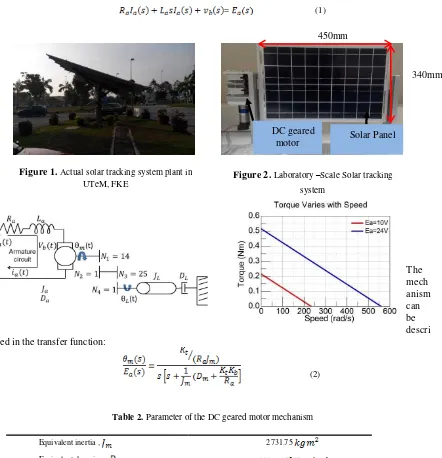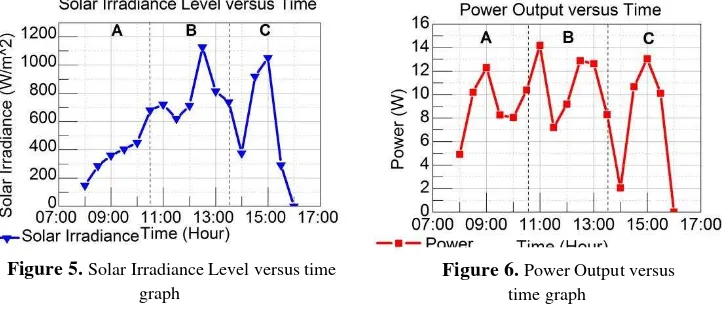1st ICRIL-International Conference on
Innovation in Science and Technology (lICIST 2015)
IICIST 2015 Proceedings 645
20th April 2015, Universiti Teknologi Malaysia, Kuala Lumpur, Malaysia
Design and Implementation of a Laboratory-Scale Single Axis Solar
Tracking System
Allan Chan Roong SOON1, Shin-Horng CHONG1*, Chin Kim GAN1
1
Faculty of Electrical Engineering, Universiti Teknikal Malaysia Melaka, Hang Tuah Jaya, 76100 Durian Tunggal, Melaka, Malaysia.
* corresponding author: [email protected]
Abstract
The renewable solar energy can be produced by using the Photovoltaic (PV) panel which converts the solar energy to the electrical energy. Global warming can be reduced by using the solar energy to generate electricity. Therefore in this project, an active type single axis solar tracking system is designed and constructed. The solar tracking system can enhance the amount of solar energy harvest throughout the day as compared to the fixed solar panel. A laboratory-scale single axis solar tracking system is developed to have a better understanding on the working mechanism of the solar tracking system. By using the laboratory-scale system, the system becomes portable and convenient to be allocated at the suitable workplace for solar tracking process. Moreover, the laboratory scale solar tracking system can be easily controlled and programmed by the users such as angle of rotation of the solar panel and the direction of rotation. In this project, microcontroller is used as an integrated control unit and the plant is actuated by the DC geared motor.
The validity of the laboratory-scale single axis solar tracking system was examined experimentally. The solar tracking system operates by rotating to the desired angle in every hour. The workspace of the solar tracking system is determined and identified. The solar tracking system workspace must be identified and examined carefully before the installation to prevent any accidents occurred during operation. This research is important for Faculty of Electrical Engineering of Universiti Teknikal Malaysia Melaka (UTeM) to identify the safety workspace for the solar tracking system due to the actual solar tracking system plant is still cannot be operated because of the limited workspace.
Keywords.
Solar Tracking System; MPPT; Single Axis1.
Introduction
The world population isincreasing throughout the year and the electricity demand is also growing rapidly. Most of the countries use fossil fuels such as crude oil to generate the electricity and the carbon dioxide, will be produced and causes global warming. The temperature on our earth is increasing throughout the year and the scientists estimate that the world temperature will raise up six degree if the greenhouse gases emissions are let uncontrollable [1]. Solar energy has more benefits compare to other renewable energy due to solar energy is inexhaustible and environment friendly. The solar energy can be converted into electricity by using the photovoltaic panels [2]. Malaysia government is supportive in development of renewable energy such as solar energy by developing the Sustainable Energy Development Authority (SEDA Malaysia). SEDA is a statutory body under the Ministry of Energy, Green Technology and Water. Malaysia Feed in Tariff (FiT) scheme is managed by SEDA Malaysia. The house owners who install the home solar system can sell the generated electricity to Tenaga Nasinal Berhad (TNB) through the national grid network [3]. In this project, an active type single axis solar tracking system will be designed and developed. By constructing the laboratory-scale single axis solar tracking system, the electromechanical system of the solar tracking system can be studied. Besides, the laboratory-scale solar tracking system can be easily controlled by the users based on the understanding of the system. Moreover, the laboratory-scale solar tracking system is convenient to move for doing the experiment. The laboratory-scale solar tracking system can also be used in the teaching and learning process for understanding the behavior and operation of the solar tracking system.
2.
BACKGROUND STUDY
Malaysia is very suitable to install the solar PV system due to the coordinate on the earth. Malaysia is at
Allan Chan Roong SOON ., et al.
IICIST 2015 Proceedings 646
20th April 2015, Universiti Teknologi Malaysia, Kuala Lumpur, Malaysia
than 10 hours sunlight every day and 6 hours direct sunlight which has the solar irradiation level between
800 . Due to the long period of receiving sunlight, Malaysia has a great potential to
develop the solar energy[4-5]. The active type solar tracking system consists of controller, sensor and actuator to function the system. Active type solar tracking system is chosen in this research due to it has the greater accuracy as compared to passive type solar tracking system [5]. In Malaysia, the sunlight is always directly located on the land and its solar radiance does not vary by seasons. Malaysia is at equator and do
not have four seasons’ occur; therefore, it is suitable to use the single axis tacking system instead of dual axis tracking system. In Malaysia, the altitude of the sun’s position does not change much [4]. According to[6] and [7], if the altitude is slightly misaligned, it only causes less power loss. According to [8], the greatest sun elevation difference in UTeM, Melaka is only which lead to only less than 3.4% of power loss. Table 1 shows the direct power loss due to solar panel misalignment is shown where loss=1-cos (I) [6].
Table 1. Direct power loss (%) due to misalignment (angle) [6]
In this project, single axis solar tracking
According to Davidsson H. and Niko G. in [9-10], the flexible and laboratory scale solar tracking system can be used for the teaching facilities and provide an opportunity for the researchers to perform the research based on the solar energy. Furthermore, the laboratory scaled solar system can also be used as a basic set of tools or start up for the local researcher [10]. They can perform the installation and maintenance on the solar system independently without required any oversea expertise. The researchers can also enhance and improve the existing solar system by using the knowledge gained such as including the tracking system and maximum power point tracking (MPPT) controller into the system to increase its efficiency. The laboratory scale solar system is very important to the developing countries such as Africa countries. In Africa, there is less than 25% of the population who has access to electricity[9]. By introducing the small-scaled stand-alone PV system to the African, they can generate their own electricity by using the solar source which is always available and free [9]. The laboratory-scale solar tracking system can be used as a teaching utility in university and generate electricity in the rural area.
3.
RESULTS AND DISCUSSION
Figure 1 shows the actual solar tracking system plant in FKE, UTeM with the dimension of 11800 (l) 6000 (w) mm and have the total surface area around 70 . In this project, the laboratory-scale solar tracking system is scaled down to ratio 462: 1 in comparison to the actual plant. The dimension of the laboratory-scale solar panel is 450 (w) 340(l) mm (see Figure 2). The solar tracking mechanism is driven by DC geared motor. The schematic diagram of the DC motor geared mechanism is illustrated in Figure 3.
F.B. Akande., et al.
IICIST 2015 Proceedings 647
20th April 2015, Universiti Teknologi Malaysia, Kuala Lumpur, Malaysia
450mm
340mm
The mech anism can be descri bed in the transfer function:
(2)
Table 2.Parameter of the DC geared motor mechanism
Equivalent inertia , 2731.75
Equivalent damping ,
Terminal resistance , 2Ω
Back-EMF constant , 42.88
Torque constant , 42.90
After substitute the value into the Equation 2, the overall DC geared motor transfer function is:
Based on Figure 4, when the armature voltage, is reduced to 10V, the motor torque and speed are reduced. However, the geared motor still has the sufficient torque to rotate and hold the load at the static position. The performance of the laboratory-scale solar tracking system is validated by conducting series of experiment at the selected workplace at FKE, UTeM. An experiment has been conducted on March 31, 2015, and Figure 5 shows the solar irradiance level in UTeM, where the weather was partially sunny and cloudy. From 0800 until 1030, the solar irradiance level is increasing and the solar output also increased as shown in Part A in Figure 5 and 6. The power output in Part A (see Figure 6) decreases from 0930 to 1030 because the solar panel is shaded by the fences at the experimental location. The high solar irradiance level at the noon time produces the maximum power output as can be seen at Part B (Figure 6). Unfortunately, the
= (1)
(3)
Figure 2. Laboratory –Scale Solar tracking system
Figure Figure 1. Actual solar tracking system plant in
UTeM, FKE
DC geared
Allan Chan Roong SOON ., et al.
IICIST 2015 Proceedings 648
20th April 2015, Universiti Teknologi Malaysia, Kuala Lumpur, Malaysia
solar irradiance levels are not constant due to the cloudy condition. In Part C (Figure 6), the power output is low due to the cloudy condition and it started to rain at 1600. This condition can be evidenced by the solar irradiation level in Figure 5. The energy output obtained by the solar panel is 74.3Wh and the energy usage by the solar tracking system only 73.68Wh. It has save around 0.85% energy output.
4.
CONCLUSION
The laboratory-scale single axis solar tracking system was successfully designed and constructed. The workspace limitation of the solar tracking system can be identified and determined by using the laboratory-scale solar tracking system. The laboratory-laboratory-scale solar tracking system can be used in the teaching and learning process. Although the energy output is low at the cloudy condition, but the designed solar tracking system still able to be used as a stand-alone solar tracking system due to the low power consumption of the mechanism. The solar tracking system can be tested at the open area to prevent from shaded to enhance the performance of the system.
5.
REFERENCES
[1] “Global warming close to becoming irreversible-scientists | Reuters.” [τnline]. Available: http://www.reuters.com/article/2012/03/26/us-climate-thresholds-idUSBRE82P0UJ20120326. [Accessed: 21-Oct-2014].
[2] R. Dhanabal, V. Bharathi, R. Ranjitha, A. Ponni, S. Deepthi, and P. Mageshkannan, “Comparison of Efficiencies of Solar Tracker systems with static panel Single- Axis Tracking System and Dual-Axis
Tracking System with Fixed Mount,” vol. 5, no. 2, pp. 1λ25–1933, 2013.
[3] “FiT-SEDA-Malaysia - Home solar|Photovoltaic|Solar voltaic|Sun solar|Solar sun|Solar panel|Power solar|Panel solar|Solar cells|Renewable energy|Solar energy|Solar|Solar pv|Solar power|solar electricity|green energy|Renewable Energy||Go green|passive income.” [τnline]. Available: http://www.fit-seda-malaysia.com/. [Accessed: 21-Oct-2014].
[4] A. Ghazali M. and A. M. Abdul Rahman, “The Performance of Three Different Solar Panels for Solar
Electricity Applying Solar Tracking Device under the Malaysian Climate Condition,” Energy Environ. Res. Vol. 2,No. 1;2012, vol. 2, no. 1, pp. 235–243, May 2012.
[5] J. F. Lee and σ. A. Rahim, “Performance comparison of dual-axis solar tracker vs static solar system in
Malaysia,” 2013 IEEE Conf. Clean Energy Technol., pp. 102–107, Nov. 2013.
[6] M. H. Tania and M. S. Alam, “Sun tracking schemes for photovoltaic panels,” 2014 3rd Int. Conf. Dev. Renew. Energy Technol., pp. 1–5, May 2014.
[7] P. Sharma and σ. Malhotri, “Solar Tracking System using Microcontroller,” Proc. od 2014 1st Int. Conf. Non Conv. Energy (ICONCE 2014), no. Iconce, pp. 77–79, 2014.
[8] “Calculation of sun’s position in the sky for each location on the earth at any time of day.” [τnline]. Available: http://www.sunearthtools.com/dp/tools/pos_sun.php#help_Date. [Accessed: 21-Oct-2014]. [9] H. Davidsson, R. Bernardo, J. Gomes, N. Gentile, C. Gruffman, L. Chea, and B. Karlsson,
“Construction of Laboratories for Solar Energy Research in Developing Countries,” Energy Procedia, vol. 57, pp. 982–988, 2014.
[10]G. σiko, “Construction of a small scale laboratory for solar collectors and solar cells in a developing country,” Engineering, vol. 05, no. 01, pp. 75–80, 2013.
Figure 5. Solar Irradiance Level versus time graph

